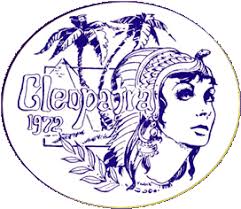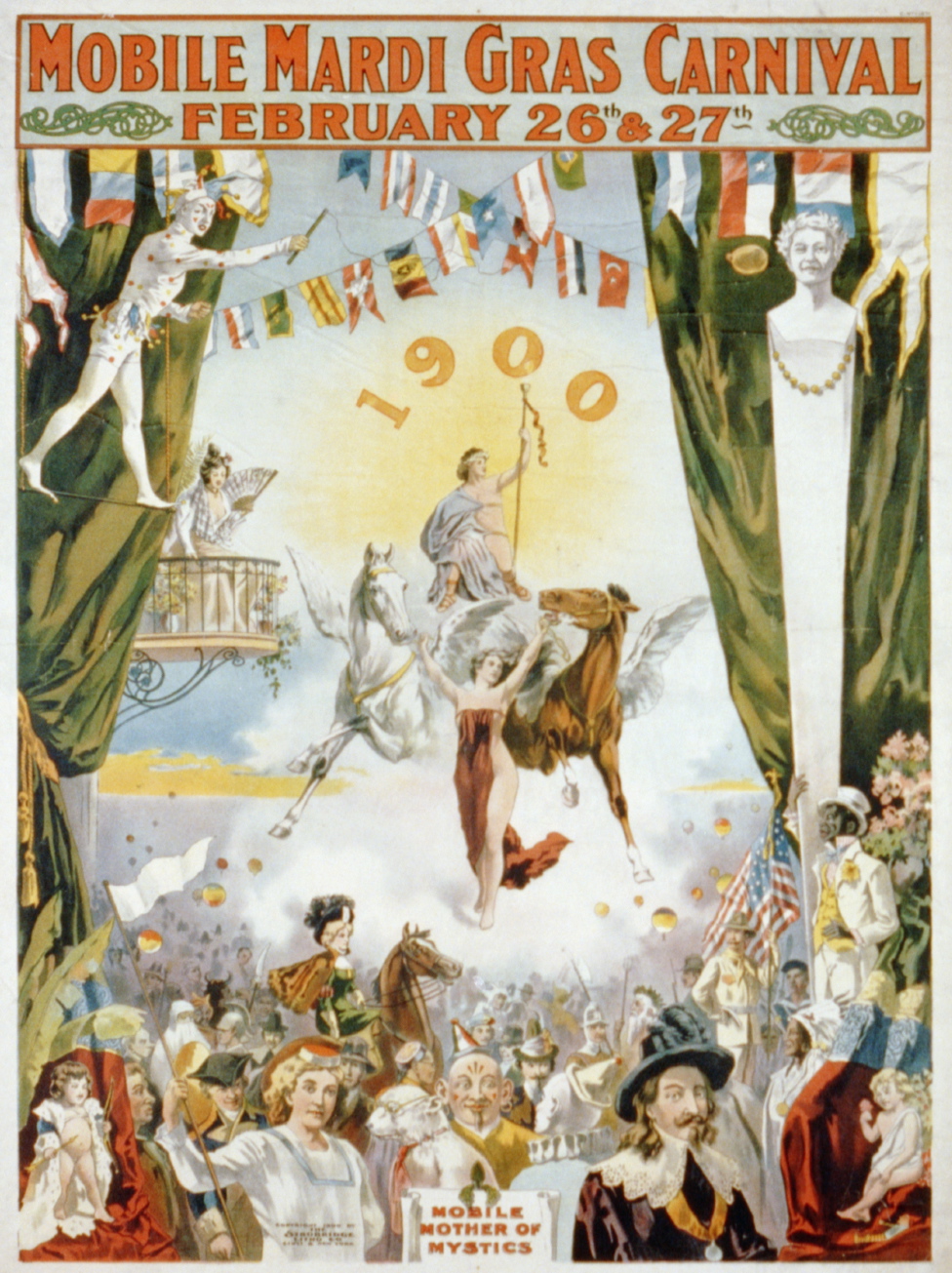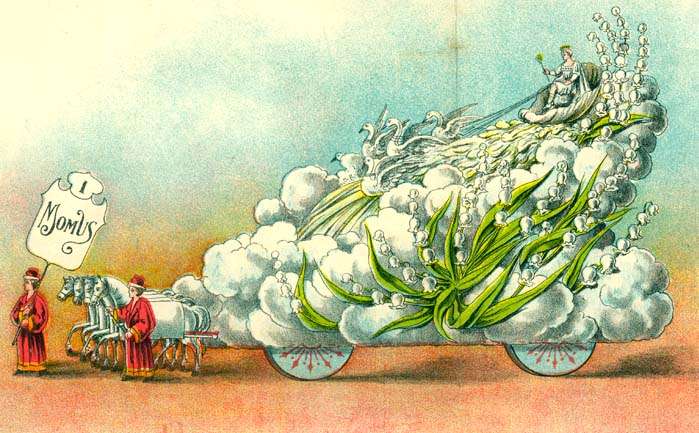|
Krewe
A krewe (pronounced "crew") is a social organization that puts on a parade or ball for the Carnival season. The term is best known for its association with Mardi Gras celebrations in New Orleans, but is also used in other Carnival celebrations around the Gulf of Mexico, such as the Gasparilla Pirate Festival in Tampa, Florida, Springtime Tallahassee, and Krewe of Amalee in DeLand, Fl with the Mardi Gras on Mainstreet Parade as well as in La Crosse, Wisconsin and at the Saint Paul Winter Carnival. The word is thought to have been coined in the early 19th century by an organization calling themselves Ye Mistick Krewe of Comus, as an archaic affectation; with time it became the most common term for a New Orleans Carnival organization. The Mistick Krewe of Comus itself was inspired by the Cowbellion de Rakin Society that dated from 1830, a mystic society that organizes annual parades in Mobile, Alabama. (List of events.) Membership Krewe members are assessed fees in order to pay for ... [...More Info...] [...Related Items...] OR: [Wikipedia] [Google] [Baidu] |
Mistick Krewe Of Comus
The Mistick Krewe of Comus, founded in 1856, is a New Orleans, Louisiana, Carnival Krewe. It is the oldest continuous organization of New Orleans Mardi Gras festivities. Before Comus was organized, Carnival celebrations in New Orleans were mostly confined to the Roman Catholic Creole community, and parades were irregular and often very informally organized. Comus was organized by largely French Catholics and Protestant Anglo-Americans. History and formation Building on the initial work of what French Creole American nobleman, and playboy, Bernard de Marigny had done in 1833, funding the first official Mardi Gras; celebration, in December 1856, six Anglo-American men of New Orleans gathered at Dr. John Pope's Drug Store on the Corner of Jackson and Prytania, a favorite rendezvous for the young men of the Fourth District, to begin to organize a secret society to observe Mardi Gras in a more formal and organized fashion than their Creole predecessors.Arthur B. LaCour, ''New Or ... [...More Info...] [...Related Items...] OR: [Wikipedia] [Google] [Baidu] |
Mardi Gras In New Orleans
The holiday of Mardi Gras is celebrated in all of Louisiana, including the city of New Orleans. Celebrations are concentrated for about two weeks before and through Shrove Tuesday, the day before Ash Wednesday (the start of lent in the Western Christian tradition). Usually there is one major parade each day (weather permitting); many days have several large parades. The largest and most elaborate parades take place the last five days of the Mardi Gras season. In the final week, many events occur throughout New Orleans and surrounding communities, including parades and balls (some of them masquerade balls). The parades in New Orleans are organized by social clubs known as krewes; most follow the same parade schedule and route each year. The earliest-established krewes were the Mistick Krewe of Comus, the earliest, Rex, the Knights of Momus and the Krewe of Proteus. Several modern "super krewes" are well known for holding large parades and events (often featuring celebrity guests ... [...More Info...] [...Related Items...] OR: [Wikipedia] [Google] [Baidu] |
Krewe Of Proteus
The Krewe of Proteus is a New Orleans Carnival Krewe, founded in 1882, the oldest continuous parading Old Line Krewe. History and formation The Krewe of Proteus is the longest riding Old Line Night Parade Krewe in New Orleans Carnival after the Mistick Krewe and the Knights of Momus, stopped parading in 1992. The parade of the krewe of Proteus traditionally travels an Uptown or St. Charles route ending on Canal Street. Parade floats still use original chassis from the early 1880s. Proteus is an offshoot of Mistick Krewe, and Knights of Momus - formed because the Mistick Krewe's waiting list was too long. Supposedly the Captain of the Mistick Krewe made the suggestion to form Proteus, as it was taking even too long for younger men of Comus families to get into Knights of Momus.New Orleans Carnival Balls: The Secret Side of Mardi Gras, 1870-1920, Jennifer Atkins, LSU Press, Sep 13, 2017 Parade Krewe of Proteus parades on the evening of Lundi Gras prior to the Krewe of Orphe ... [...More Info...] [...Related Items...] OR: [Wikipedia] [Google] [Baidu] |
Krewe Of Cleopatra
The Krewe of Cleopatra is a New Orleans Mardi Gras Super Krewes and social organization. History and formation The Krewe of Cleopatra is one of the few Super Krewes with only female members (with over 1,800 members and one of the largest parades participating in the New Orleans Mardi Gras). The Krewe of Cleopatra was founded in 1972 by Dolores "Tuttie" Kepner, becoming the first Carnival Club for women on the West Bank of the Mississippi River. 1973 was the first year the Krewe paraded with 250 members. The Krewe made its permanent move from the West Bank to the East Bank after the 2013 carnival season becoming the first all-female organization on the Uptown parade route. From 1972 to 1975 Cleopatra was co-captained by two sisters, Dolores Kepner and Joycelyn Champagne. Having appreciated parades their entire lives as natives of New Orleans, the two women decided to work together administrating an all female carnival club. Kepner's husband William Dill put them in touch wit ... [...More Info...] [...Related Items...] OR: [Wikipedia] [Google] [Baidu] |
Gasparilla Pirate Festival
The Gasparilla Pirate Festival is a large parade and a host of related community events held in Tampa, Florida almost every year since 1904. The theme of the festivities is a friendly invasion by the mythical pirate José Gaspar (also known as Gasparilla), who is a popular figure in Florida folklore even though there is no evidence that he actually existed. The centerpiece of Gasparilla is the Parade of Pirates (often referred to as ''the'' Gasparilla Parade), which is held on the last Saturday in January and is organized by Ye Mystic Krewe of Gasparilla (YMKG), a local organization modeled after the "krewes" of Mardi Gras in New Orleans. On Gasparilla Day, members of YMKG sail across Tampa Bay aboard the ''Jose Gasparilla'', a specially built "pirate ship" equipped with loud mini-cannons that fire continuously during its journey. Surrounded by thousands of revelers on private boats, the pirates make their way to the Tampa Convention Center, where the mayor surrenders the key to the ... [...More Info...] [...Related Items...] OR: [Wikipedia] [Google] [Baidu] |
Ye Mystic Krewe Of Gasparilla
The Gasparilla Pirate Festival is a large parade and a host of related community events held in Tampa, Florida almost every year since 1904. The theme of the festivities is a friendly invasion by the mythical pirate José Gaspar (also known as Gasparilla), who is a popular figure in Florida folklore even though there is no evidence that he actually existed. The centerpiece of Gasparilla is the Parade of Pirates (often referred to as ''the'' Gasparilla Parade), which is held on the last Saturday in January and is organized by Ye Mystic Krewe of Gasparilla (YMKG), a local organization modeled after the "krewes" of Mardi Gras in New Orleans. On Gasparilla Day, members of YMKG sail across Tampa Bay aboard the ''Jose Gasparilla'', a specially built "pirate ship" equipped with loud mini-cannons that fire continuously during its journey. Surrounded by thousands of revelers on private boats, the pirates make their way to the Tampa Convention Center, where the mayor surrenders the key to the ... [...More Info...] [...Related Items...] OR: [Wikipedia] [Google] [Baidu] |
Rex Parade
Rex (founded 1872) is a New Orleans Carnival Krewe which stages one of the city's most celebrated parades on Mardi Gras Day. Rex is Latin for "King", and Rex reigns as "The King of Carnival". History and formation Rex was organized by New Orleans businessmen in part to put on a spectacle in honor of the New Orleans visit of Grand Duke Alexei Alexandrovich of Russia (remembered locally as "Grand Duke Alexis") during the 1872 Carnival season. Also in the minds of the founders of Rex was the desire to lure tourism and business to New Orleans in the years after the American Civil War. Rex has held more parades in New Orleans than any other parading organization. Its official song is "If Ever I Cease to Love", a quirky tune from the 1870s musical "Bluebeard". This was adopted because the Grand Duke Alexis of Russia had a fondness for Lydia Thompson, the actress who sang the song in the musical, which was playing in New Orleans at the time of the first Rex parade in 1872. It ha ... [...More Info...] [...Related Items...] OR: [Wikipedia] [Google] [Baidu] |
Springtime Tallahassee
Springtime Tallahassee is an annual event held on either the last Saturday in March or the first Saturday in April in Tallahassee, Florida, United States celebrating Tallahassee's history and culture. History Springtime Tallahassee began in 1967 as a concept to keep Tallahassee as the state capital. At the time, Florida had its first Legislature based on reapportionment in which Florida legislators from southern and central Florida were insisting that the capitol be in a more centralized location. Tallahassee's civic and business leaders mapped a strategy and proposed it to their legislative delegation asking for help. As the legislative session advanced, unkind comments about Tallahassee were made by legislators. This prompted the Junior League of Tallahassee with the Junior League taking the southern and central legislators' wives on a bus tour of old homes in Tallahassee and nearby Monticello. This drew an enthusiastic response. The Rotary Club produced a Chamber of Commerce ... [...More Info...] [...Related Items...] OR: [Wikipedia] [Google] [Baidu] |
Saint Paul Winter Carnival
The Saint Paul Winter Carnival is an annual festival in Saint Paul, Minnesota, United States. History In 1885, a New York reporter wrote that Saint Paul was, "another Siberia, unfit for human habitation" in winter. Offended by this attack on their city, the Saint Paul Chamber of Commerce decided to prove not only that Saint Paul was habitable but that its citizens were very much alive during winter, their most dominant season. A Winter Carnival had been held over the border in Montreal with an ice castle in 1885. With a model to draw upon the Saint Paul Winter Carnival was created in 1886. It was followed by carnivals held in 1887, 1888 and 1896. The Carnival was held again in 1916 and 1917. There was another lapse until 1937 when they continued through 1942. WWII interrupted life in general, but the Carnival resumed in 1946. It remains an annual event today. In 1886, King Boreas the First was crowned and the first Winter Carnival commenced. This festival also featured an ... [...More Info...] [...Related Items...] OR: [Wikipedia] [Google] [Baidu] |
Mystic Society
A mystic society is a Mardi Gras social organization in Mobile, Alabama, that presents parades and/or balls for the enjoyment of its members, guests, and the public. The New Orleans Krewe is patterned after Mobile's Mystics."Carnival/Mobile Mardi Gras Timeline" (list of events),The Museum of Mobile, 2002, webpagMoM-timeline(link dead) archiveArchived page The societies have been based in class, economic and racial groups. Mobile's parading mystic societies build colorful Carnival floats and create costumes around each year's themes. During the Carnival season, the mystic societies parade in costume on their floats throughout downtown Mobile. Masked society members toss small gifts, known as ''throws'', to the parade spectators. The ''throws'' can take the form of trinkets, candy, cookies, peanuts, panties, artificial roses, stuffed animals, doubloons, cups, hats, can coolers, Frisbees, medallion necklaces, bead necklaces of every variety, and Moon Pies. Mystic societies in Mob ... [...More Info...] [...Related Items...] OR: [Wikipedia] [Google] [Baidu] |
Krewe Of Muses
The Krewe of Muses is an all-female super krewe and social organization. History and formation The Muses were founded in 2000 by Staci Rosenberg and first paraded during Mardi Gras in 2001. Since then the krewe has grown to include approximately 1100 members. The krewe's parade is held on the Thursday evening before Mardi Gras, and features 25 floats designed by Kern Studios. Parade Krewe of Muses parade on Jeudi Gras, the Thursday night prior to Mardi Gras. The parade starts at Magazine Street and Jefferson street in Uptown New Orleans; proceeds east to Napoleon street where it follows Knights of Babylon and Knights of Chaos. Parade themes Krewe of Muses season parade theme is secret until Jeudi Gras. The theme is always satirical. In 2006, to honor the victims of Hurricane Katrina, the Muses had at the tail end of their parade an empty float which evoked the riderless horse that follows the caisson carrying the casket in a funeral procession.Best of New Orleans Music ... [...More Info...] [...Related Items...] OR: [Wikipedia] [Google] [Baidu] |
Knights Of Momus
The Knights of Momus ("KoM") was founded in 1872 and was the second-oldest parading Old Line Krewe in the New Orleans Carnival after the Mistick Krewe, and is the third oldest krewe to continuously present a tableau ball, after the Twelfth Night Revelers in 1870. For over 100 years, the Momus parade was a fixture of the New Orleans Mardi Gras parade schedule, parading annually on the Thursday before Fat Tuesday. Since Momus was the Greek god of mockery, the themes of Momus parades typically paid homage to the organization's namesake with irreverent humor and biting satire. The 1877 parade theme, "Hades, A Dream of Momus," caused an uproar when it took aim at the Reconstruction government established in New Orleans after the Civil War. Attempts at retribution by local authorities were largely unsuccessful due to the secrecy of the membership. In 1991, New Orleans City Council member Dorothy Mae Taylor passed an ordinance that required social organizations, including Mardi Gr ... [...More Info...] [...Related Items...] OR: [Wikipedia] [Google] [Baidu] |






.jpg)





